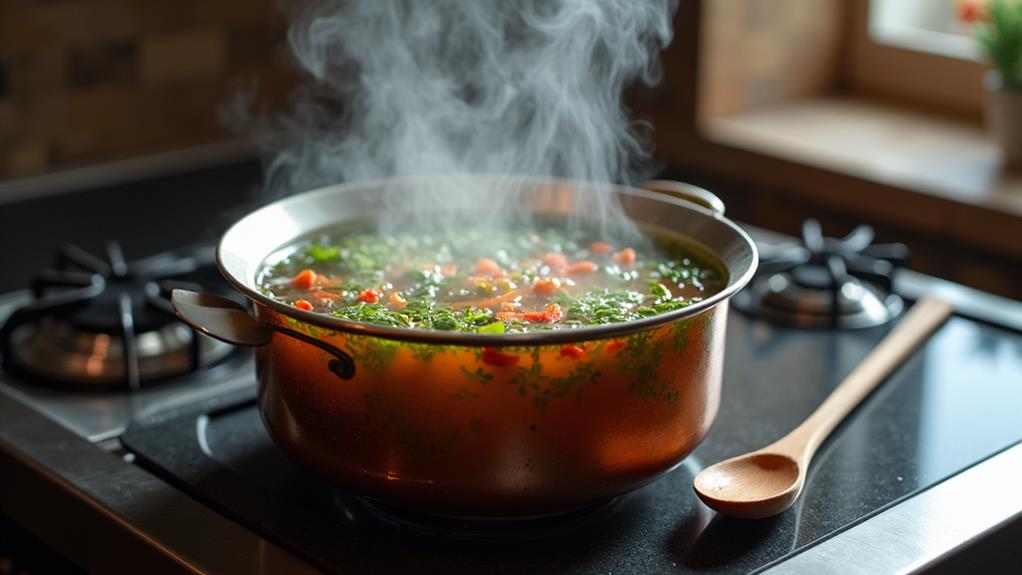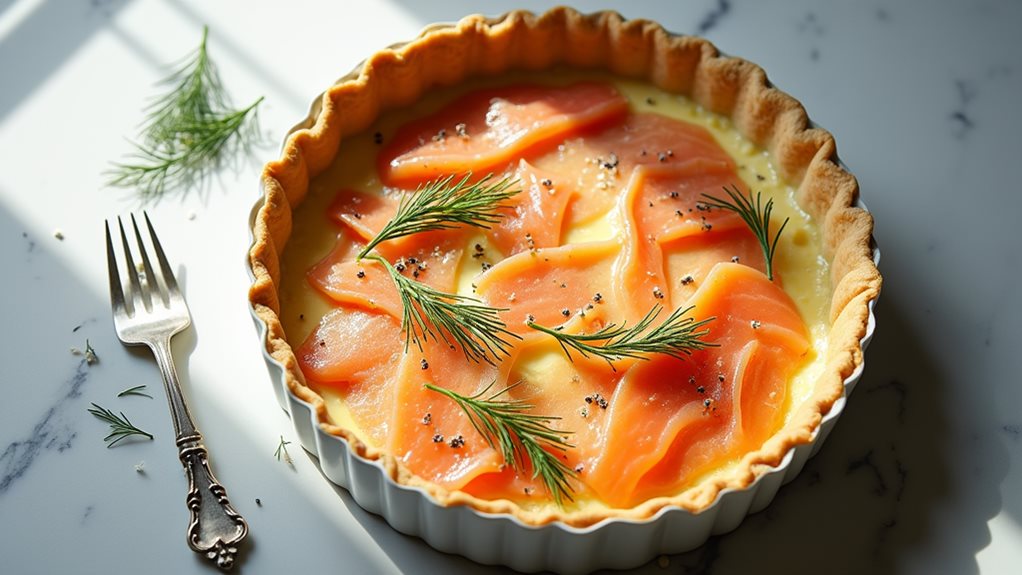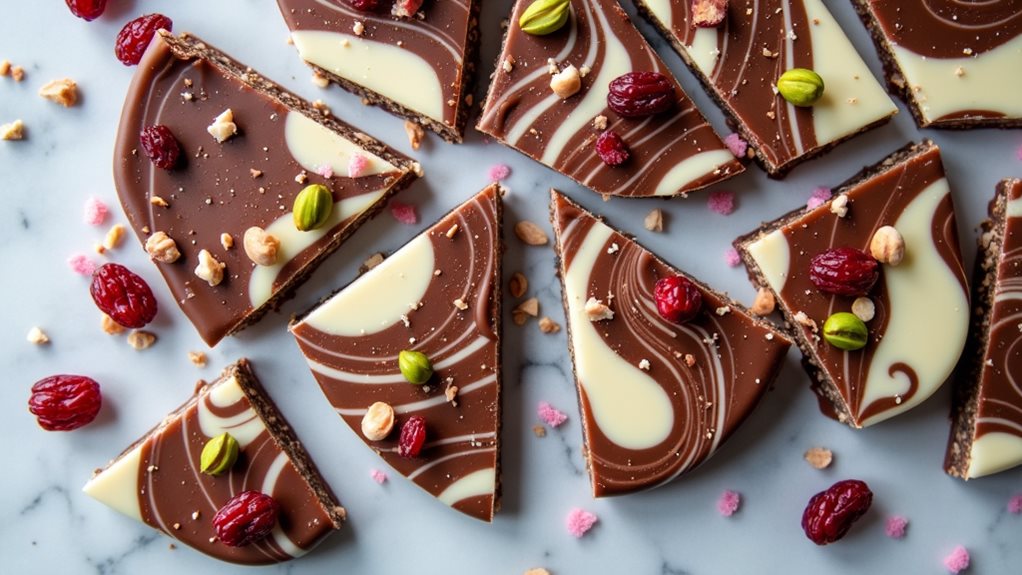Elevate your cooking with three powerful spice-infusion techniques. First, bloom spices by heating them in oil or ghee, releasing essential oils for intensified flavors. This works well with both whole and ground spices, but be careful not to burn them. Second, toast whole spices in a dry skillet to enhance pungent flavors, shaking the pan frequently until a nutty aroma emerges. Grind immediately to preserve potency. Finally, create zesty aromas through simmering infusions, combining herbs, spices, or citrus zest with liquids for 15-30 minutes. Strain and use the flavored liquid in soups, sauces, or marinades. These methods will transform your dishes from ordinary to extraordinary.
Blooming Spices for Aromatic Depth
To unlock the full potential of your spices, blooming them is a game-changer. This technique involves gently heating dry spices in oil or ghee before adding other ingredients, releasing their essential oils and intensifying their flavors. You'll notice a dramatic difference in the depth and complexity of your dishes.
For instance, the simplicity of dishes like lentils with spring greens can be elevated by incorporating this method, enhancing their existing flavors.
Start by selecting your spice combinations carefully, considering how different flavor profiles will interact. Heat a small amount of oil in a pan over medium heat, then add your chosen spices. Stir constantly for 30 seconds to a minute, until you detect a rich, fragrant aroma.
Be cautious not to burn the spices, as this can result in bitter flavors. Once bloomed, immediately add your next ingredients to stop the cooking process. This method works particularly well with whole spices like cumin seeds, mustard seeds, and cardamom pods.
It's also effective for ground spices such as turmeric, paprika, and coriander. Experiment with various combinations to create unique, aromatic bases for curries, stews, and marinades.
Toasting Techniques for Pungent Flavors
While blooming spices enhances their aromatic qualities, toasting takes pungent flavors to new heights. This technique unlocks a deeper, more intense taste profile that'll revolutionize your cooking. Consider how toasting spices could enhance a dish like Slow Cooker Chili Con Carne, where the flavors of cumin and chili seasoning can greatly benefit from this method.
To begin, select whole spices rather than pre-ground versions for optimal results. Heat a dry skillet over medium flame and add your chosen spices, shaking the pan frequently to prevent burning. You'll know they're ready when you detect a rich, nutty aroma wafting from the pan.
Experiment with different spice combinations to create unique flavor pairings. Try toasting cumin seeds with coriander for a Middle Eastern twist, or mix fennel seeds with black peppercorns for an Italian-inspired blend. The key is to toast each spice separately, as they've varying cooking times.
Once toasted, grind your spices immediately to preserve their potency. Use them in rubs, marinades, or sprinkle directly onto dishes for an instant flavor boost. Remember, toasted spices are more concentrated, so use them sparingly at first and adjust to taste.
With practice, you'll master this technique and elevate your culinary creations to new heights.
Simmering Infusions for Zesty Aromas

Simmering infusions unlock a world of zesty aromas that can transform your cooking. This technique involves gently heating ingredients in liquid to extract their essence, creating a flavorful base for your dishes. For an added twist, consider incorporating seasonal vegetables and herbs for depth, reminiscent of dishes like Harvest Vegetable Soup.
To start, select your preferred herbs, spices, or citrus zest, and combine them with water, oil, or vinegar in a saucepan. Bring the mixture to a gentle simmer, then reduce the heat and let it steep for 15-30 minutes, depending on the intensity you desire.
Experiment with innovative herb blends to create unique flavor profiles. Try combining rosemary, thyme, and sage for a Mediterranean-inspired infusion, or mix lemongrass, ginger, and kaffir lime leaves for an Asian twist.
Don't forget the power of citrus zest; lemon, lime, or orange peels can add a bright, tangy note to your infusions. Once your infusion is complete, strain out the solids and use the flavored liquid as a base for soups, sauces, or marinades.
You can also reduce the infusion further to create a concentrated syrup for drizzling over desserts or mixing into cocktails. By mastering this technique, you'll elevate your dishes with complex, aromatic flavors that will impress even the most discerning palates.
Frequently Asked Questions
How Long Can I Store Homemade Spice Blends?
You'll maximize your spice blend shelf life by storing it in airtight containers. Typically, they'll stay fresh for 6-12 months. Experiment with vacuum-sealed options or add oxygen absorbers to push the boundaries of flavor preservation.
Are There Any Spices I Should Avoid Mixing Together?
Like a chaotic orchestra, clashing spices can create dissonance. You'll want to consider spice compatibility and flavor balance. Generally, avoid mixing overpowering spices like cinnamon and cumin. Instead, experiment with complementary flavors to create innovative, harmonious blends.
Can I Use Dried Herbs Instead of Fresh in Infusions?
You can absolutely use dried herbs in infusions! They're convenient and pack a punch. While fresh herbs offer vibrant flavors, dried herbs bring concentrated intensity. Experiment with both to discover unique flavor profiles and elevate your culinary creations.
What's the Best Way to Grind Whole Spices at Home?
Prepare to unleash a flavor explosion! You'll revolutionize your spice grinding techniques with these mortar alternatives. Blast spices in a coffee grinder, pulverize with a rolling pin, or zap them in a high-powered blender for mind-blowing results.
How Can I Adjust Spice Levels for Different Heat Tolerances?
You'll master spice balance by starting with less and gradually increasing. Experiment with heat-reducing ingredients like dairy or acidic elements. Remember, everyone's heat tolerance differs, so customize dishes to suit individual preferences for innovative flavor experiences.
Final Thoughts
You've now gained potent, palate-pleasing powers to transform your cooking. By blooming spices, toasting for tanginess, and simmering for savory scents, you'll create culinary masterpieces that'll captivate your guests. Remember, these techniques aren't just tricks; they're tried-and-true traditions that top chefs treasure. So, don't be shy – start experimenting today. With practice and patience, you'll perfect these methods, and your dishes will dance with delightful, deep flavors that'll leave lasting impressions on every diner's taste buds.















